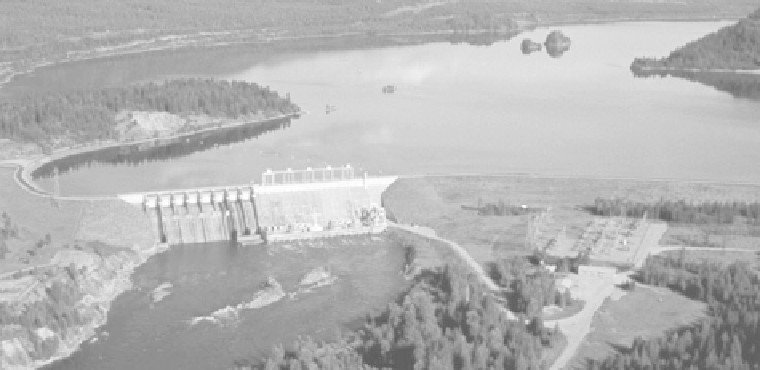Environmental Engineering Reference
In-Depth Information
Figure 7.2
The Noxon Rapids dam on the Clark Fork River in Montana generates 466 MW. (By permission
of George Perks/Avista Corp.)
7.2.1
Environmental Effects
Hydropower plants can have severe environmental effects. Where a reservoir is formed behind a
dam, aquatic and terrestrial ecosystems are greatly altered. Downstream of the dam, the riverine
flow is altered, interfering with the ecosystems that have adjusted to the natural variable river
flow pattern. The reservoir interrupts the natural siltation flow in the river and its contribution to
alluvial deposits downstream. The flooding of land that previously served for agriculture and human
habitation may be a significant social and economic loss. The construction of dams interferes with
the migration of anadramous fish and adversely affects their populations, even where fish ladders
are employed. Currently, removal of U.S. hydropower dams in the Pacific northwest and Maine
have been recommended to revive endangered salmon fisheries.
7.3
BIOMASS
Until the onset of the industrial revolution led to the exploitation of fossil fuels, wood was the
principal fuel available to humans, being used for cooking and space heating. In many developing
nations today, wood supplies up to half of the energy consumption, which is very low on a per capita
basis. Wood crops, a renewable resource, replace themselves every 50-100 years. The amount of
non-food-producing land available for energy crops, like wood, is insufficient to supplant entirely
current fossil fuel consumption. Nevertheless, a variety of agricultural and silvicultural crops or
their byproducts can contribute to energy supplies and thereby replace some fossil fuel consumption.
Another form of biomass that can be converted to a useful fuel is animal waste. Digesters
can generate methane from farm animal or human wastes, with the residue of this process being
suitable for crop fertilizing. Organic matter in municipal waste landfills generates methane in an
uncontrolled process that can supply low heating value gas.
In the United States in 1997, biomass provided 29% of renewable energy and 1.25% of total
energy. It also contributed 13% of renewable electric power and 1.7% of all electric power.

